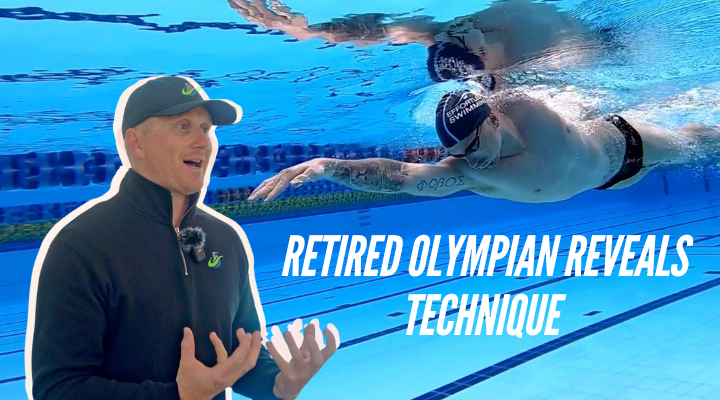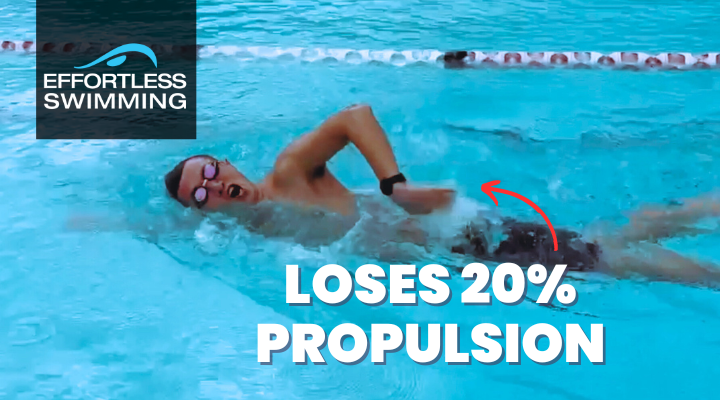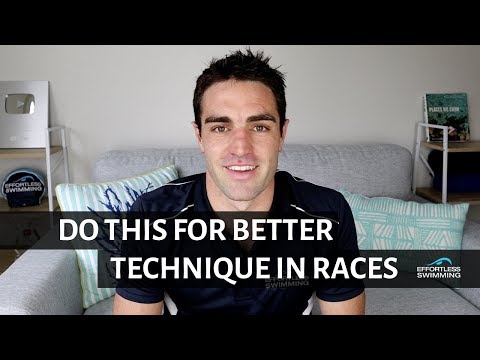This swimmer can swim at 1:50/100m pace but quickly drops to 2:15/100m pace. We look at his breathing, kick and catch and how he can hold 1:50 for longer and also swim faster in the next 3-6 months.
Transcription:
For him to get a high elbow catch with his hand that shallow, his arm is going to have to be there, and that is a really awkward position for most people with their shoulders. So, a way to just make that a lot easier is to get the fingertips down here. That’s going to make it so much easier to get a high elbow catch because it just puts the shoulder in a much more comfortable position.
Hey, Brenton here. Welcome to Feedback Friday. In today’s episode, we’re looking at a swimmer who swims around a 1:50 per 100-pace, but he said his times dropped pretty dramatically to around 2:15 per 100 as he starts to go on and as he starts to get tired. So, we’re going to have a look in this video and see what this swimmer could focus on in order to not only maintain that pace, 1:50 for longer, but eventually bring it down to 1:45, 1:40 and onwards from there. And it’s certainly possible. We’ve worked with thousands of swimmers over the last 10 years and a lot of those swimmers have been able to, over the course of six months, 12 months, and on from there, really make quite significant changes, especially if they’re around that sort of 1:50 to 2:15 mark. There’s a lot of room available and the opportunity to swim faster. So, let’s have a look at a couple of things here.
In general, the swimmer’s got quite a good head position. You can see he’s keeping that neck long and looking within the range that we normally recommend, which is sort of straight down to about 45 degrees in front. The thing that stands out to me first and was looking at here is the kick. You’ll see that the legs do drop down quite a bit, but the most noticeable thing there is if you look at the line of the body here. All right, so, we’re there, but if you look at the knees and the thighs and, sorry, the quads, they’re dropping down quite a bit below that line there. So, what it normally shows is there’s a bit too much knee bend going on, here, so the swimmer’s just bending his knees a bit too much.
The other thing that you’ll see is for most of the kick, the toes are pointing down to the bottom of the pool and it doesn’t look like much, but that right there, that’s a lot of drag that gets created and that is really going to drop the legs down. It’s very hard to overcome that drag if the toes are pointing down that much. So, the first thing I’d look to do there is just adjust the kick a little bit.
So, number one, we’d need to just straighten the legs out and get a little bit more lift through the leg. So, using your glutes, we want to be able to bring this leg up a little bit higher and a little bit straighter. At the moment there’s this constant bend through the hips, so we’ve got to engage the glutes slightly. Use that to bring your leg up somewhat straighter on some of those kicks, and that’s not only going to reduce the drag by getting the leg up higher, but it will also allow him to have better tautness through the midsection. Because if you’re swimming and you’re bent through the hips, it’s very hard to have a good connection with the hips and the rest of the body there, just because of how the hips are positioned. So, we’d look to do that, and the other thing he’d probably just need to do there is in general point the toes and turn the feet inwards a little bit. What we mean by turning the feet or the toes inwards is that’ll give you a little bit more flexion. So, if you point your toes, then turn your big toes in towards one another, that just gives you a little bit more range there with the feet, even if you are quite tight. So that’d be the first thing.
The other thing we’d probably look to do is adjust the breathing slightly. So, if you look from above in this position here, you’ll notice what happens here. The swimmer’s looking up quite high, but you see this position where the legs have splayed. Now, that’s obviously partly to do with that extra bend in the knees. That’s going to create a bit of drag there on that foot as well, but you’ll also see that there’s quite a bit of torque through the body, quite a bit of a bend through the body here. We want to generally keep the line of the body quite straight. That’s going to cut through the water a lot better than a body that’s quite bent through there.
Now, why is that bend coming in? A big part of it is just breathing. So, once we look from the side here, you can sort of see it here, you can just see that the whole head is out of the water, looking up a little bit too high there, at about a 45-degree angle. I’d encourage him to look a bit more to the side. Now he doesn’t necessarily need to keep his whole goggle in the water or anything like that. It will help for him to keep the top part of his head in the water a little bit more, look directly to the side and it would be good to see maybe part of that bottom goggle in the water, but it’s just when the head turns so far, then the body will always go with it just because it’s … Particularly if you’re stiff, it’s going to go with it. So, that’d be the second thing. One of the drills I like there, we’ve talked about the FKB drill, front kick breathe drill. A really simple one, just to get used to breathing more to the side. It can be a very good one for that.
Then the next thing, and this is probably where the biggest increase in speed will come from overtime, is what’s happening out in front with the arms. So, you’ll see here that his recovery is good, his entry is good, and as he comes through here, right, that entry is good. You’ll see what happens immediately there. The fingertips come up to the surface and he puts the brakes on there. The fingertips are rising up. So, it’s creating quite a bit of drag. Now, that’s not a … Yes, it’s going to slow him down, but really it’s what happens next that’s going to limit his speed quite a bit.
So, we see with both hands that as we go through here, elbow’s the lowest part of the arm, he’s just pressing down on the water. What we want to do instead is get the fingers by the wrist, wrist below the elbow, have that slight downwards angle there. It’s going to help them set the catch up a lot better. But the thing that really stands out is he pulls through too shallow through this first part.
So, as we go from here to here, you’ll notice he’s pulling straight back. If you look at elite swimmers, the position that the fingers move through or the line that the fingers take. So, like a quarter of a circle. Kind of takes that position through there, a quarter of a circle. So, we want to just sort of tip the fingers down, keep that hand and forearm moving through. That’s just going to allow you to get over the top of that arm as opposed to pulling straight back there where you’re too shallow and it just puts the arm in a position that’s a little bit awkward and it’s very difficult to get a high elbow catch if your hand is this shallow.
So, if you look at the forearm and hand at the direction it’s facing, it’s mostly down, a little bit back, but mostly down. If you want to propel yourself forward, you’ve got to try and get that forearm and hand angled in a way that’s mostly back behind you. But for him to get a high elbow catch with his hand that shallow, his arm is going to have to be there, and that is a really awkward position for most people with their shoulder.
So, a way to just make that a lot easier is to get the fingertips down here. That’s going to make it so much easier to get high elbow catch because it just puts the shoulder in a much more comfortable position. So, if we look at that from the front, you’ll see this here. All right, so we’re out in front. Not a bad position to start. That’s a good position to start in. As he tips those fingertips down, comes in quite shallow there and the elbows kind of dropping a little bit there. So, we’d work on … We’d want to work on that, but the position there, yeah, probably just coming in a little bit too shallow in that arm.
So, we’d want to see just the fingertips coming down a little bit more. It’s probably more evident on this left-hand side. See how those fingertips are off to the side. And if we look at that angle, it’s about 70 degrees probably, yeah, 70 degrees through that arm. We were on [inaudible 00:07:31] at the moment in Thailand, and one of the things that we worked on with one swimmer was he was doing exactly the same thing, trying to get that high elbow catch, where his fingers were at going off to the side and his elbow was sitting quite low.
So what we got him to do was feel like the hand was going extra deep and extra wide. And then we got into this position here where the fingertips are more pointing down and we get to this, what we call a power dominant position, which you may have seen in some other Feedback Fridays. And in that sort of position, you can be so much stronger through the shoulders, through the back. Your hand and forearm have a lot more surface area as you’re pressing back there and you can get a lot more out of the stroke. So, a lot of people in there trying to go for that high elbow position, sometimes they overdo it where they’re sort of sweeping inwards there, fingers come off to the side.
Now, keep those fingers pointing mostly down there and if you find that that’s where you get to, a good drill, the drill that I’d probably recommend here and that we did with the swimmer in Thailand is the YMCA drill, which you’ve probably seen in a lot of our other videos. Yeah, we refer to it a lot. But the thing is it’s so effective at making changes to a lot of the issues that come up or the faults that come out in the catch in the pool, that it’s worth … it can correct a lot of things there. So that’s probably the drill I’d recommend for this swimmer to help work on that.
The other thing you’ll notice here is that he tends to slice through the water with his hands. So, we’ve got the palm facing back behind him there, but right now, notice that pitch of the hand. Palms facing inwards. So it’s just slicing out the back and he’s lost that pressure on the hand and forearm there. So it’s just sort of slipping through and then there, get a little bit there, but it’s still slicing out the back. About half of the pool, oh, sorry, the last half that the press phase there, the hands just really slicing out. So, if he’s able to keep his palm facing back behind him and using his forearm and his hand to keep that surface area pressing back, he is going to get so much more out of every stroke that he takes. It’s going to be a lot less effort. It’s going to be a lot easier to do and he’s going to travel a lot further with each stroke. And the same thing possibly on that side. It’s a little bit hard to tell.
So, they’re really some of the main things that I’d be looking to work on with this swimmer and obviously looking to improve on that high elbow position or somewhere in that sort of range because there’s a big opportunity there. But I would start with the kick. I’d start with engaging the glutes slightly, slightly straighter kick. Point the toes. Get the breathing right first, then probably focus on the catch, because as you know, we like to sort of follow the process where we want really good fundamentals and we want to start with the basics of essentially posture, body position, kick and breathing. Start there. Then generally working on the more challenging aspects of the stroke, where we’re looking at catch, pull and press, and then rhythm and timing and a couple of other things there. So, start with some of the most basic, the most fundamental things. Get those right and then go from there.
Now if you did enjoy today’s video, please like, subscribe, and comment below. It helps us reach more people. And we’ve got a number of camps that are coming up, so if you haven’t been to our website yet, check out the camps we’ve got coming up in 2020. We have two camps in Hawaii, two camps in Noosa, in Queensland, Australia and we’ve also got our Thailand camps as well. So, lots of camps next year where you can join myself and a number of other effortless swimming coaches, where we work with you on a one on one basis for a lot of the camp, where we get to do underwater filming, analysis and look at your stroke and work with you very closely over the course of either five days or a week. And we’ve just wrapped up our Thailand camps at the moment, and we’ve seen some big improvements, up to 30% in some swimmers in terms of how much faster they’re swimming.
So go and check out our website. I’ll put the link below and you can see where those camps are and you can join in the ones that aren’t sold out yet. So, looking forward to meeting some of you there. We’ve also got clinics in Australia and we’ve also got obviously the online video membership where you can access our technique courses. The one that most people tend to go first or use first is the Virtual Freestyle Clinic. And this is where we just take it step by step through each part of the stroke, build it up with just a handful of drills, and we give you the exact sort of program that you can take to the pool, follow and just build, build on what your current stroke is, and that’s what we recommend for most people. That’s the Virtual Freestyle Clinic inside the video membership if you can’t come to a clinic or a camp in person. Thanks for watching. I’ll see you next week.









